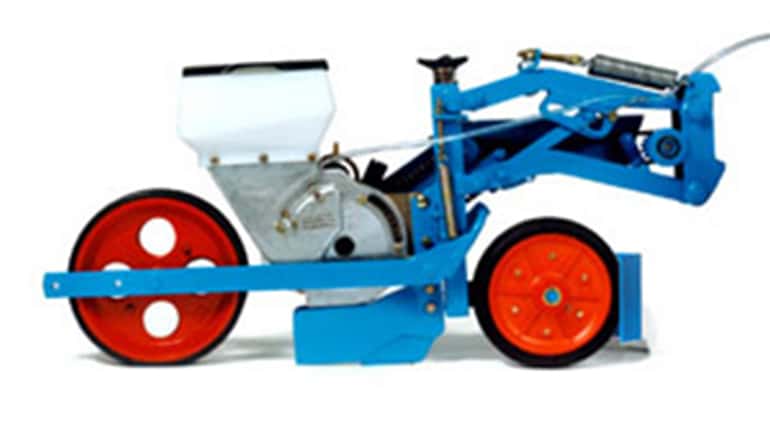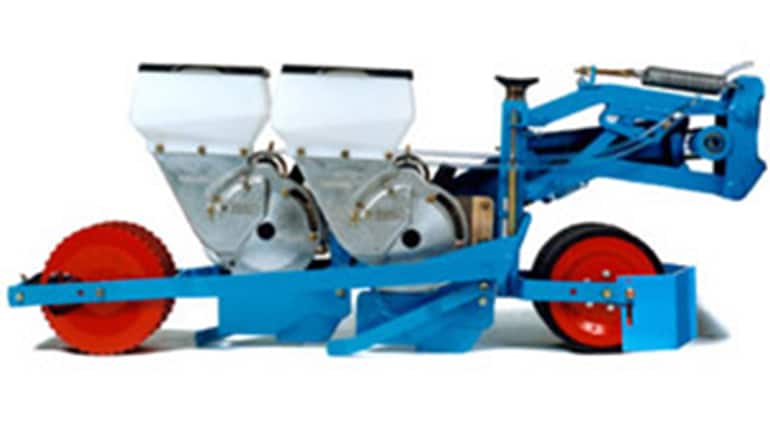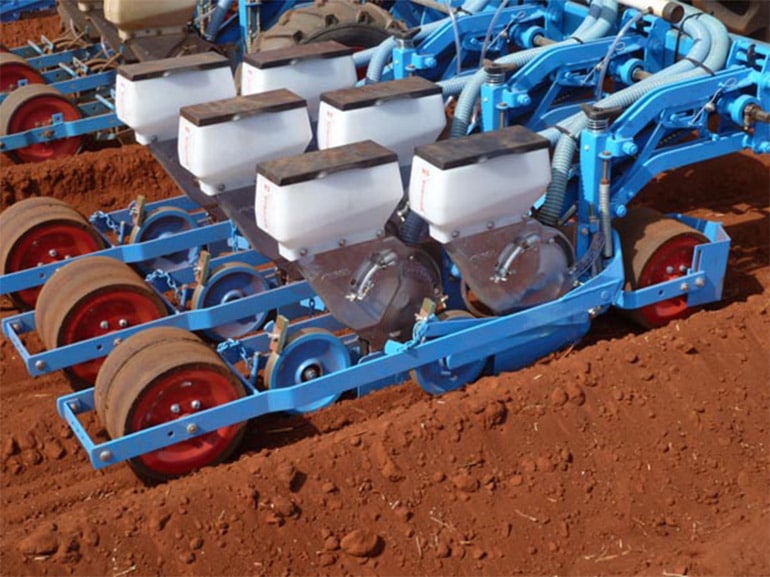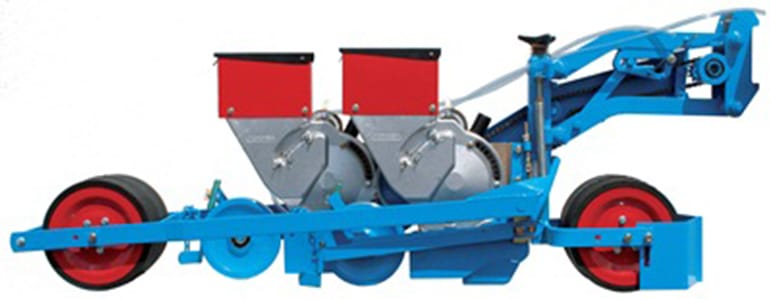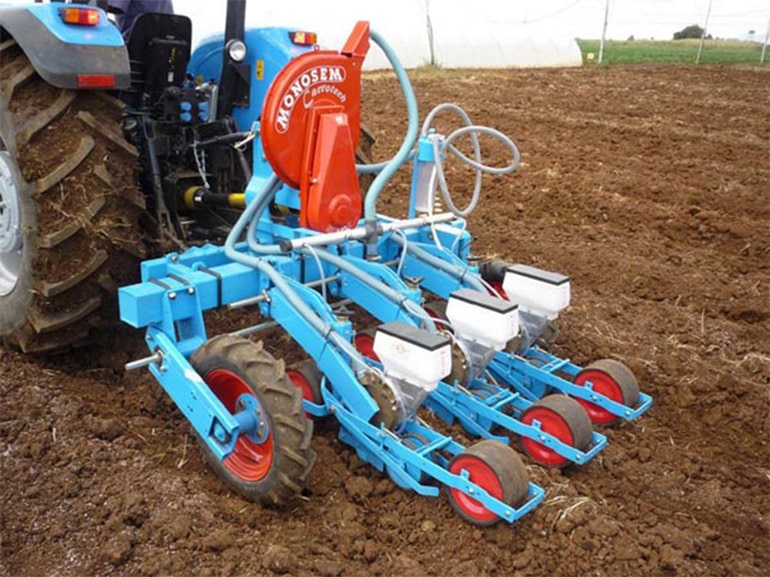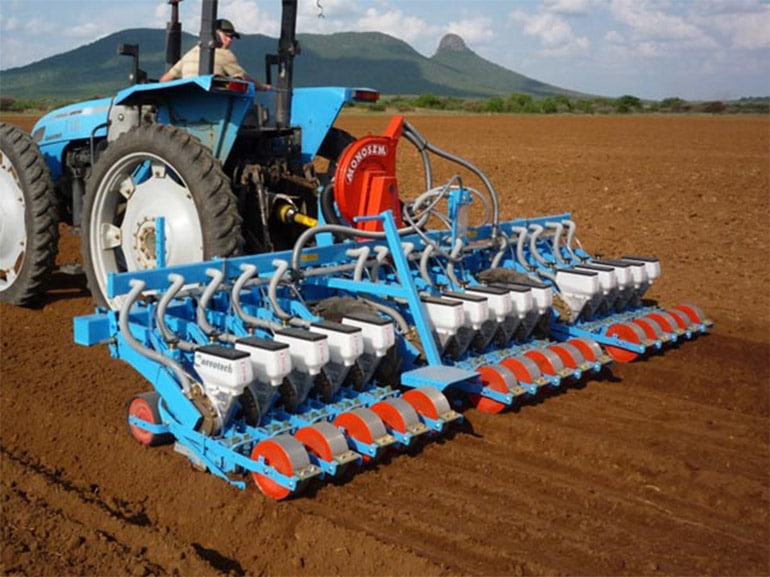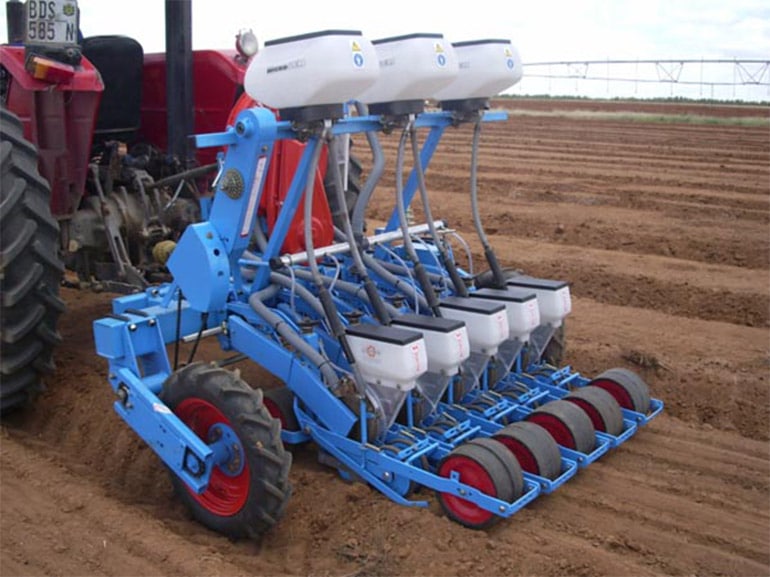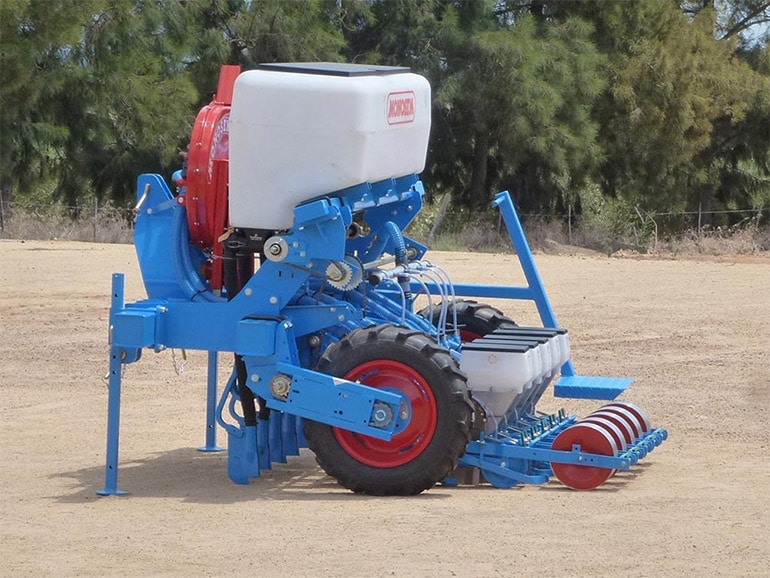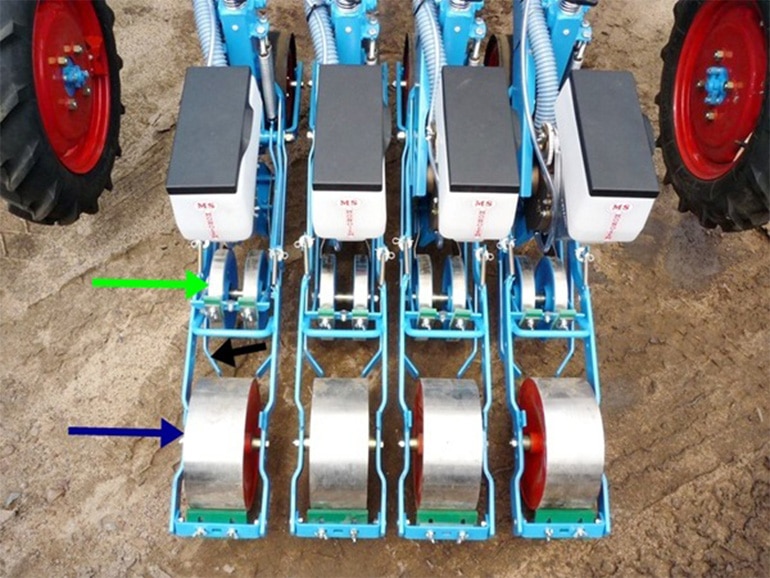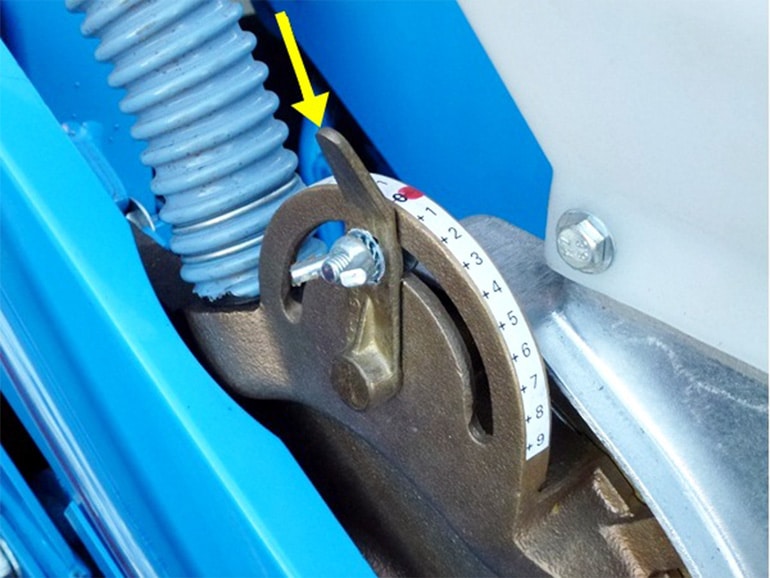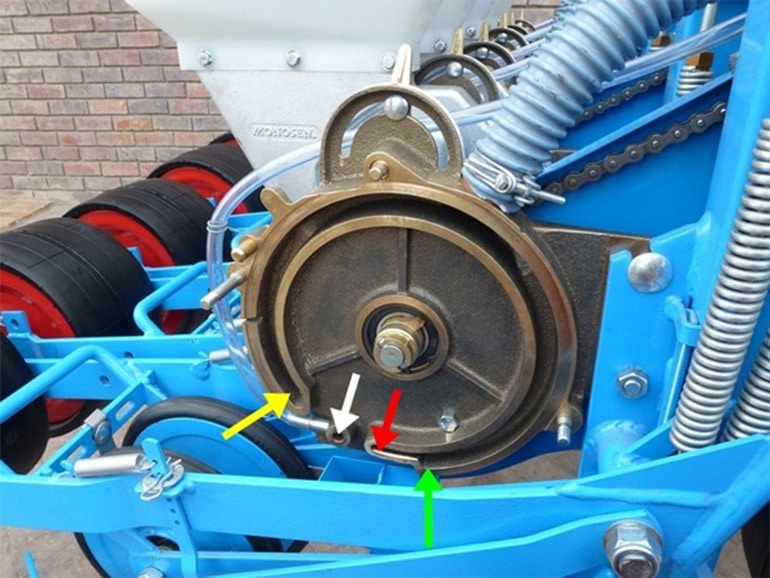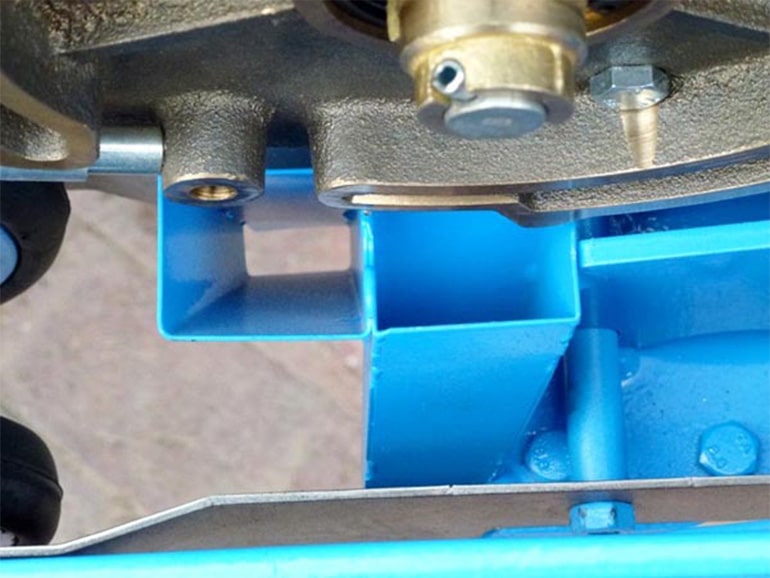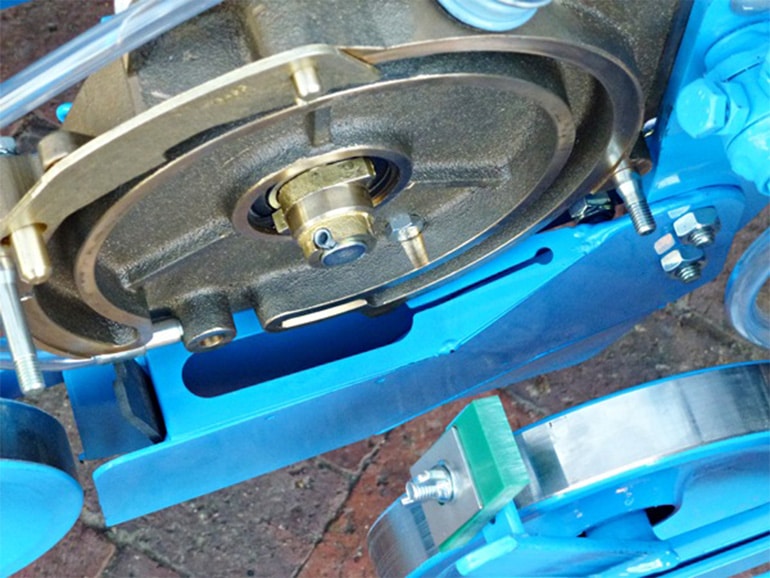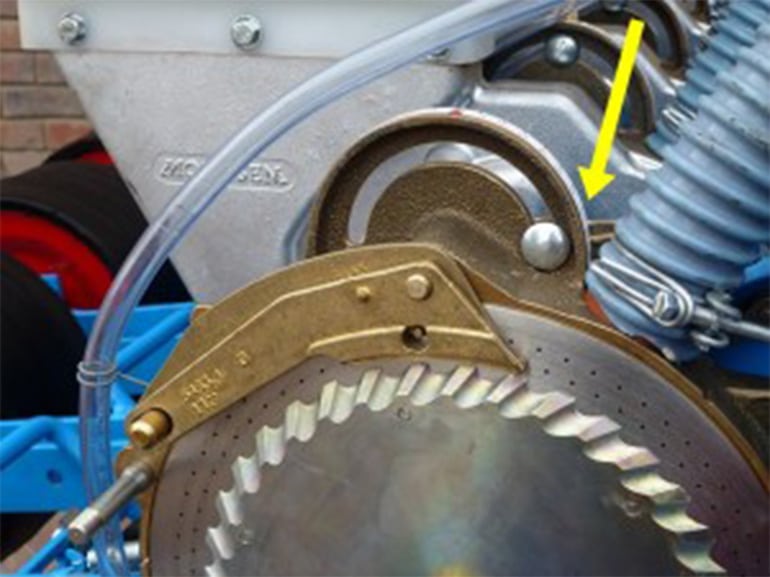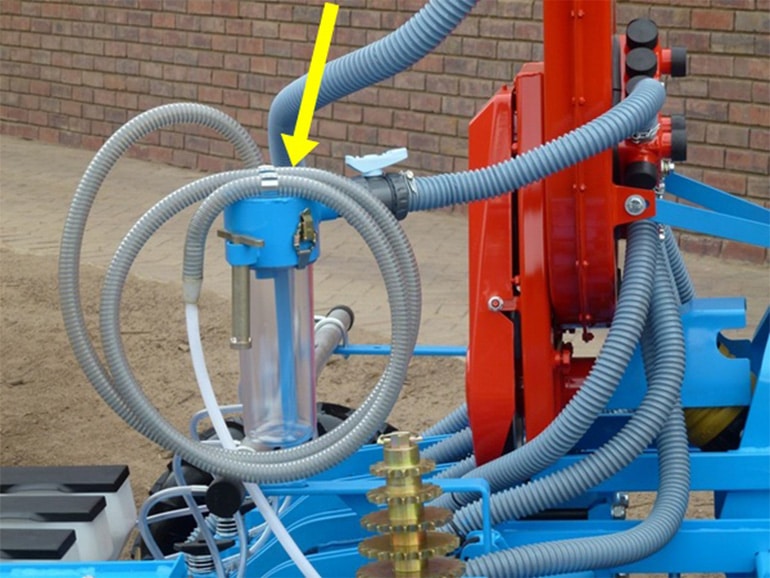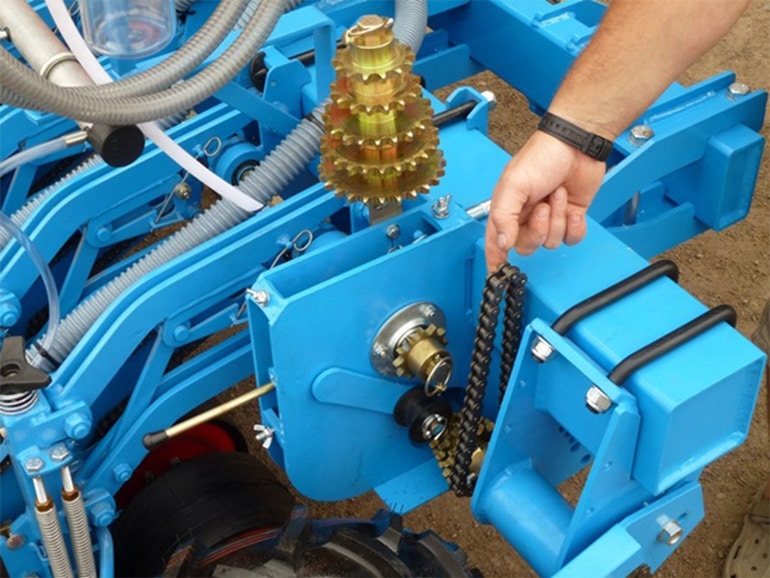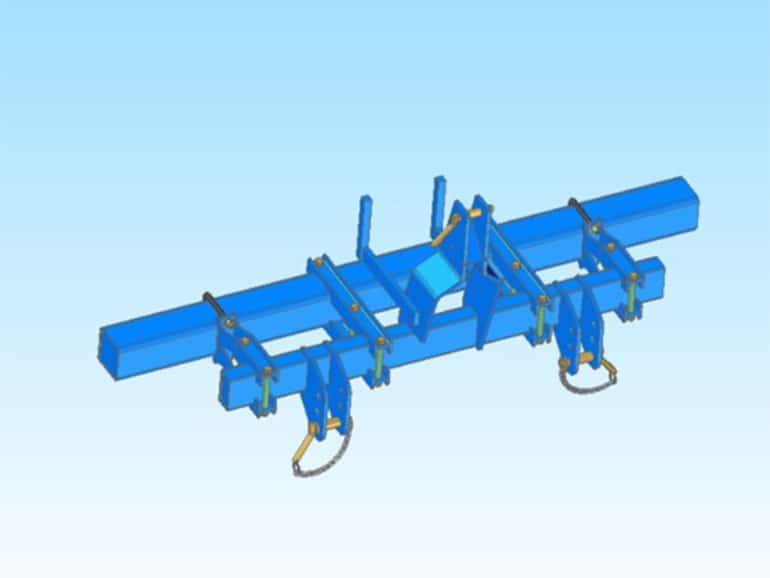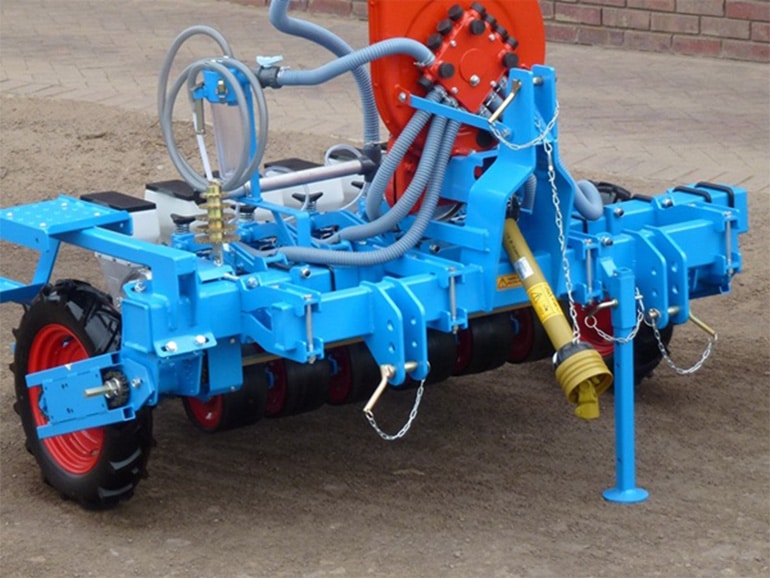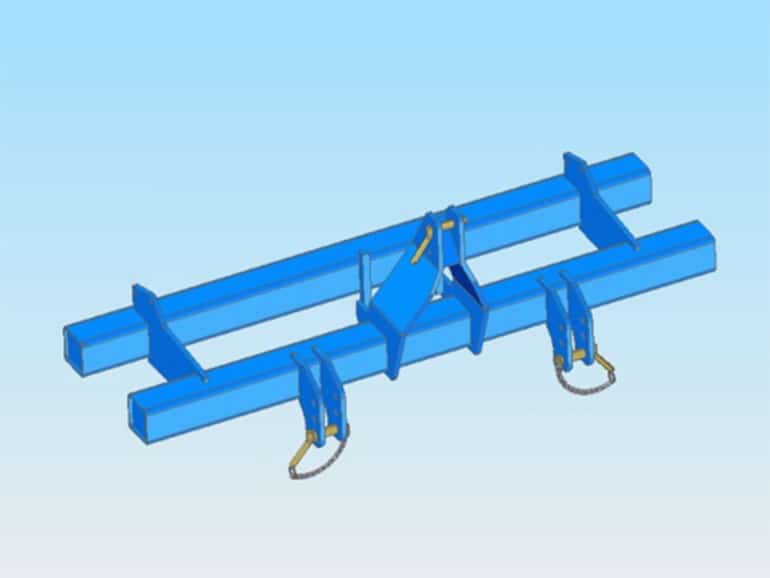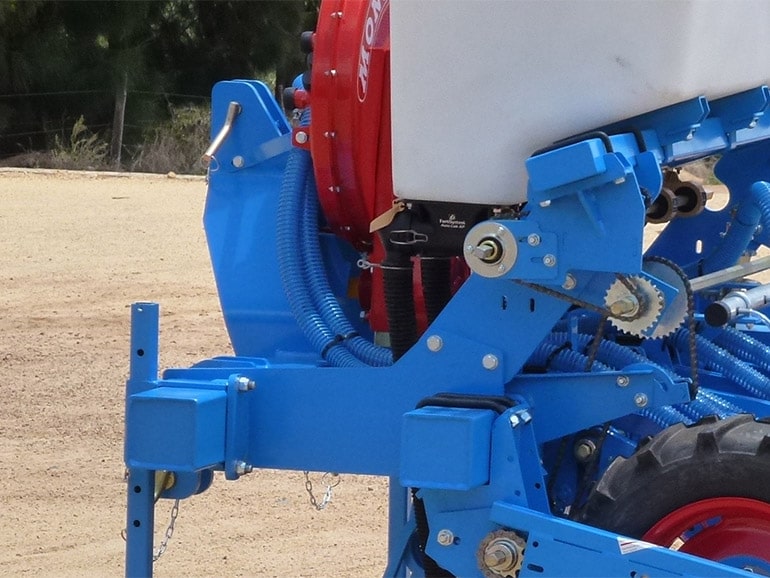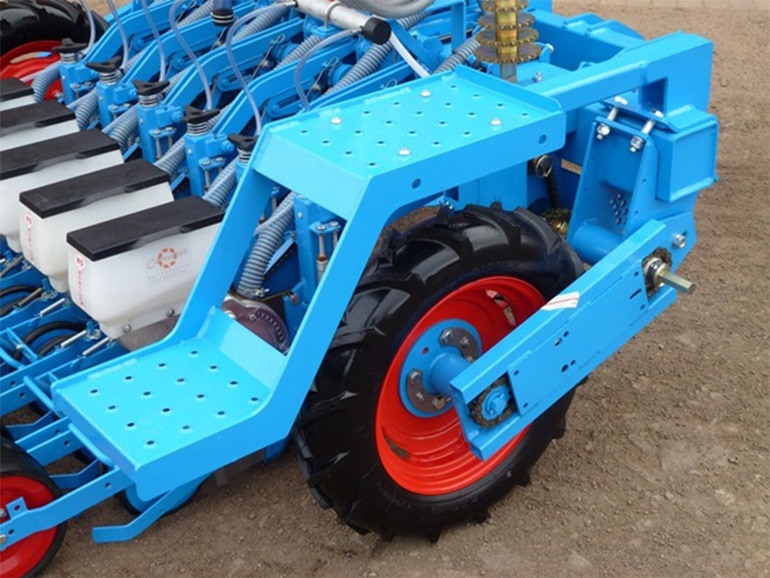Vegetable Planters
The Monosem MS vegetable planter is by far the best selling pneumatic planter for vegetables and other fine seeds in South Africa. Every year since Carrotech started marketing it in 2000 it sells in numbers far higher than any other vacuum fine seed planter on the South African market.
Today there are more than 400 of these planters running in South Africa. They are used in every province, in the roughest conditions, right through the year, and they give their owners many years of good service without much maintenance.
- very sturdy and solid
- very durable and low maintenance
- highly precise and
- easy to adjust and to use
Background :
The Monosem company in France is Europe’s biggest manufacturer of precision planters. Monosem planters have been in this country for more than 30 years. Up to this day everyone who has worked with one or who is farming next to a Monosem owner knows : There is no other planter that can match the precision of a Monosem.
They were the first and only precision vacuum planters that were available for maize, sunflower and other crops for many years after 1974. In 1988 Monosem introduced their new generation vacuum mechanism “NG” featuring major improvements that added to the durability and simplicity of the popular maize planter.
In 1997 Monosem introduced their fine seed planter “MS” ( Mini Seed ) borrowing many components from it’s big brother, the NG which made the machine far stronger than you would expect a vegetable planter needs to be.
Monosem offers 4 different planter row units for vegetables and fine seeds.
Version A
The “Version A” is a single row unit that is the most commonly used for spinach, turnips and other vegetables that would better grow in a single line. It is possible to convert a single row Version A into a double row Version C and the other way around within a few minutes but it requires additional components and parts to do the conversion. The Version A planter unit also requires a minimum row distance of 20cm.
Version B
The “Version B” is a very narrow single row unit. It only requires a minimum row distance of 14cm and can be used if you require a row distance closer than 20cm for crops that would perform better in single lines against the double lines.
Version C
The “Version C” as a double row unit is the most commonly used model for onions, carrots, beet-root and other vegetables. It is designed to plant a 7cm double line of seeds with one seed metering unit. ( A 5cm double line is possible with a different seeding shoe.) Each planter unit requires a minimum row distance of 20cm
Version D
The “Version D” is usually a double row planter but can also be assembled as a triple row unit. It is always built with two single seed metering boxes on one carrier. It requires a minimum row distance of 26cm. The distance of the double row can be adjusted from 8cm to 11.5cm. This isespecially advantageous where larger crops are planted that prefer a double line but that would not grow to their full size if the double row is planted too close. Should the Monosem Version D planter unit be assembled as a triple row the front metering unit will be a single line and the rear unit will be a double line. All lines will be planted 5cm apart.
Version D2
The “Version D2” is a longer double row planter unit with two single seed metering boxes on one carrier similar to Version D but it has two extra heavy cast iron intermediate press wheels that run behind the seed shoe and press the new seeds firmly into the ground to make sure there is good “seed to soil contact” and no air pockets remain underneath the seed. It also requires a minimum row distance of 26cm as Version D and the distance of the double row can also be adjusted from 8cm to 11.5cm.
Possible planter configurations :
The Monosem MS fine seed planter is always assembled to your specifications. The quantity of row units that you require depends on the crop you intend to plant and the space you have available between the tyres of your tractor.
Double row planter
A customer that plants carrots with a tractor that runs on 1.5m wheel centre distance would most probably buy a 3 double-row MS while an onion farmer that can set his tractor track to 2.3m might order his machine with eight planter units. While almost everything is possible, most planters for carrots leave the Monotec workshop with 3 or 4 units and most planters for onions with 5 or 6 double row planter units.
Triple bed assemblies
Planting your crop is the most important farming operation that requires the greatest care and precision. But because the weather conditions are very often not right for planting and you only get a limited period of time when moisture and temperature are perfect, many farmers realised the need for larger planters. The assembly team at Monotec can build a Monosem MS fine seed planter for you that can easily plant more than 20 Hectares a day.
Granular insecticide and dry fertiliser options :
The application of granular herbicide, insecticide or similar products is possible with the optional “Microsem” equipment . One 18 litre hopper needs to be fitted for a max of two planter units. The Microsem augers that meter out the insecticide are highly precise and durable because the adjustment for the output is not done at their infeed nor outlet side but can only be set at the chain drive. By changing the gear ratio at the Microsem drive only, you can alter the insecticide output to the required quantity. 17 different settings are possible with the standard sprockets. Should you require more settings or finer adjustment additional sprockets are optionally available.
The application of Fertiliser is also possible with the MS planter but only if the planter is equipped with the heavier “Monoblock frame” that allows the fitment of a 250 litre or a 350 litre fertiliser hopper behind the Turbofan.
The planter unit :
The ruggedness of the Monosem MS planter body is really exceptional in it’s class. It is so solidly built that it can perform well in the roughest conditions.
The strong parallel linkage is holding the main carrier part upright at all times which ensures an even performance of the unit even in uneven terrain. The planting depth is set by the front wheel. By turning a knob (yellow arrow) that screws the front wheel lower or higher the operator can adjust how deep the planting shoe will put the seeds into the soil.
Everything else that follows the planting shoe can swivel up and down independently following the soil contour without influencing the planting depth.
Two springs (red arrow) can be tensioned to transfer weight off the front wheel onto the intermediate press wheels (green arrow) or onto the rear wheel (blue arrow).
All wheels run in a sturdy “fork type” frame that supports them from both sides. The front wheel that guides the planter unit is always a wheel with a flexible non inflated rubber tyre. The intermediate press wheels can either have a rubber tyre or a stainless steel lining according to the customer’s preference.
The intermediate press wheels (green arrow) are of utmost significance when planting. These extra heavy cast iron wheels run just behind the seed shoe and press the new seeds firmly into the ground to make sure there is good “seed to soil contact” and no air pockets remain underneath the seed that can hinder proper root growth later when the plants are young. The soils capillarity is also improved by these heavy wheels so that all the seeds get sufficient moisture to evenly germinate. Compared to other fine seed planters these intermediate press wheels on the Monosem MS really make a difference. While some competitors do not offer any intermediate wheels or if they do their wheels are much lighter the owner of a MS can be sure that his precisely planted seeds get a maximum chance of even emergence and growth.
The soil scrapers (black arrow) that follow the intermediate press wheels can be set to down pressure and height to cover the new seed with the desired amount of soil. Thereafter the wide rear wheels (blue arrow) add just the necessary re-compaction according to the spring adjustment that was set by the operator.
For the rear wheel of the planter unit (blue arrow) there are 3 different wheels available.
- A wheel with a flexible non inflated rubber tyre
- A wheel with a stainless steel lining
- A “cage wheel” aligned with an expanded metal mesh.
The stainless steel wheels work mostly in light to medium heavy soils. They are fitted with a “greenflex” scraper that keeps the wheels clean so that they leave a smooth finish. The rubber tyres work mostly in very heavy, sticky soils. This non inflated tyre does not need any scraper. Its own flexibility ensures that there is never too much soil build up around the wheel. The cage wheel is chosen in light conditions if the requirement is a fluffy finish.
The seed metering system of the Monosem MS fine seed planter :
The most important requirement for every farmer who buys a new fine seed planter is PRECISION. His highest expectation is that the new machine will give him an accurate seed singulation and perfect seed placement in the ground so that he can get the “picket fence stand” in the field which will guarantee him a good yield as a return for his investment. The Monosem MS planter fulfils this expectation with ease.
This brilliantly designed unit will give its owner years of pleasure because it is :
- highly precise and accurate
- easy to adjust,
- simple to maintain
- very durable.
By adjusting only one lever you can make sure that the result of the seed singulation inside the metering system is as close to 100% as you will ever get. Meter by meter through all the many hectares, pip by pip will go past the control window without skips or doubles
Easy access into the metering unit
By loosening two wing-nuts you can easily take off the aluminium cover of the metering system and have access to the seed disc.
Inside the cover, you can see the small opening (yellow arrow) that channels the seed from the white PVC seed hopper to the seed disc. This opening only allows a hand full of seed to have access to an area where seeds have contact to the rotating seed disc.
The green arrows in the picture above point to the two secondary seed scrapers. These two spring loaded brass pins run with their tips against the seed disc and knock off some excess seed that might have been picked up by the holes in the disc. You can not adjust these two secondary scrapers. You can only disable them if necessary.
Located at the bottom of the cover is an ejector block (red arrow). Two spring loaded curved brass ejectors run against the seed disc. These are located exactly where the vacuum behind the seed disc is cut off. They help to direct the fine seeds evenly off the disc into the seed chutes and make a major contribution to the precise seed spacing of the Monosem MS.
Stainless steel seed disc
The stainless steel Monosem seed disc is bolted onto an “agitator” whose sprocket-like edge gently agitates the hand full of seed that has contact to the disc as it rotates clockwise together with the seed disc. This brilliantly simple design agitates the seeds very efficiently without any plastic or rubber parts that can wear. The seed disc can have a double or single row of holes depending on the model and a wide variety of hole sizes is available for every crop and seed size from lettuce to cucumber. The stainless steel MS discs have a diameter of 22cm and is 1mm thick. This large diameter allows the Monosem MS to rotate their discs at a slower speed than a competitor’s model with a smaller disc while achieving the same seeding rate. The performance is enhanced and the wear is reduced by the slower rotation.
The yellow arrow points to the first and the green arrow points to the second primary seed scraper. It is their job to align a single seed to each hole and knock off any excess seed so that there are no doubles or skips, just one seed on every hole. The seed scrapers can be adjusted to work more or less aggressive by setting the singulation lever (red arrow) to a different position.
The body of the metering mechanism
Behind the seed disc is the brass body of the metering mechanism. During operation the 1mm thick stainless steel seed disc runs against a wide surface of this brass body. The friction of the harder stainless steel against the softer brass is very low. The combination of these two materials make the mechanism extremely durable and long lasting. There is no plastic or rubber used in the heart of the Monosem MS, only durable metal parts that can not warp and won’t easily wear.
The yellow arrow points to the beginning of the suction chamber where the vacuum starts to suck through the holes of the rotating seed disc. This is the area where a hand full of seeds have contact to the disc. The green arrow points to the end of the suction chamber for the first and outer row of holes while the red arrow points to the spot where suction ends for the inner row of holes.
The ejector block on the other side of the seed disc also works in this area to guide the seeds off the disc. Further left you see the white arrow pointing onto the blow hole where air from the pressure side is used to clean the holes and prevent blockage.
The seeding shoe
The seed chutes of the MS double row planter unit is steep and wide (left picture). It’s outlet is designed not to be blocked by soil which makes planting in moist conditions a pleasure. It is also not easily blocked by larger seeds. While larger size beet-root seeds easily create a bridge or blockage in the seed chutes of other planters a Monosem MS will plant it without problems.
The double row seed shoe is also well designed that clods can not be caught and dragged along (right picture). The cast iron tips (arrows) that cut the furrows in the ground are made of hard wearing material and bolt onto the shoe’s body to be replaced separately.
The single row seed shoe is designed to plant shallow or deep equally well. The cast iron tips (yellow arrow) can be replaced separately.
Unmatched accuracy
The accuracy that is possible with the Monosem MS really sets it apart from any other fine seed planter model on the market. Inside the mechanism, seed scrapers align the seeds to the holes in the seed disc and efficiently eliminate all doubles without creating any skips. As the disc turns all the seeds that are sucked to a hole have to pass multiple edges of the seed scraper and are stirred just enough that only one seed remains on every hole. By setting this lever to a more or to a less aggressive position you can easily make sure that your Monosem planter plants 100% accurate, pip by pip, every meter of it’s way.
Whether the seeds are big or small, flat or round, coated or uncoated, you can be sure a Monosem will always pick up seed. Thanks to the high air volume that is created by the Turbofan and the slow turning seed disc with larger holes than most other fine seed planters will have this MS planter will always suck seeds on the disc, in most cases it will pick up more than one. The secret for success has thus not much to do with the vacuum but with the fine adjustment of the seed scrapers. An easily accessible lever on the outer side of the Monosem metering mechanism is used to adjust the height of the seed scrapers. While the lever has a wide range of settings the seed scrapers move only a tiny little bit when you set the lever far over from an aggressive position to a non aggressive one.
The Monosem MS planter is still easy to use. Once an operator has found the setting of the seed scraper that gives him best results on the first planter unit that he calibrates he can set all other planter units to the same setting without calibrating them individually. In the Monosem factory in France all seed metering boxes are not only manufactured and machined with greatest care and precision they are also tested and calibrated with accuracy.
After calibrating every seed metering unit carefully a Monosem technician puts a mark and a sticker onto each unit so that the operator has a common “zero” mark to work from. On the right picture there are six metering boxes all set to the “zero” position. However their levers do not seem to be in line between the yellow arrows they are all set the same. Because of the common “zero” mark the operator of a MS planter can be sure that all seed scrapers aligning tiny seeds to even tinier holes will wipe off the unwanted doubles to precisely the same aggressiveness on all planter units if he has set their levers to the same setting.
Monosem MS planters use under-pressure (vacuum) to suck seed gently onto the holes of a rotating seed disc. It also uses pressure to clean the seed discs and prevent dust from blocking the holes. Both, the under-pressure and the pressure are created by a PTO driven turbine, the Monosem “Turbofan”. Being the same fan than on the bigger NG maize planters this device is over-designed for it’s duty on the MS and will most unlikely ever give you trouble. It does only create a light under-pressure of -5 KPa but it moves a high air volume which makes the system totally insensitive for variations in PTO revolutions. The operator does not need to keep his eyes on pressure gauges (which are non existing on a Monosem planter) to ensure the correct seed singulation. The MS does operate perfect even when tractor revolutions are low.
Drive wheels
Both ground wheels that carry the Monosem MS planter are driving wheels. This ensures uninterrupted running of the seed mechanism even through wet patches, ditches or extremely uneven terrain. There is nothing to set on the drive wheels. A heavy 3/4 inch chain delivers the driving force from the wheels to the 22mm hexagonal main drive shaft. What you do need to set once is the height of the toolbar or frame. When the MS planter will be planting on raised beds the operator needs to set the ground wheels to carry the frame much higher than when planting on flat fields. One bolt (yellow arrow) is loosened on each ground wheel and set to a different position to achieve a lower or higher toolbar height.
Seed spacing transmission
Frames :
Standard MS Frame
The standard frame is a bolted construction of a 127 x 127mm square beam in the rear and a 120 x 60mm rectangular beam in the front. Certainly strong enough this frame caters for all standard assemblies with or without Microsem applicators.
Monoblock Frame
The other option is the “Monoblock” frame which is a welded construction of a 127 x 127 square beam in the rear and another beam in the front of the same size. This frame is used when the application of fertiliser is requested or when a ridger attachment is fitted to the MS planter.





